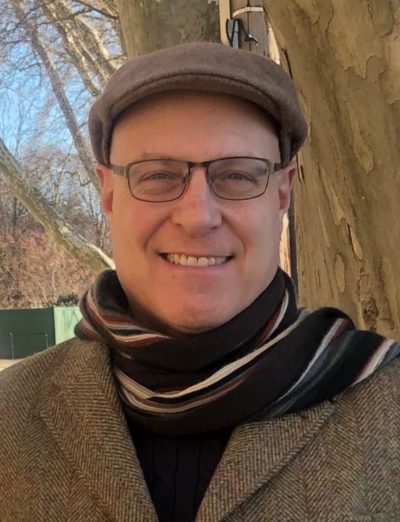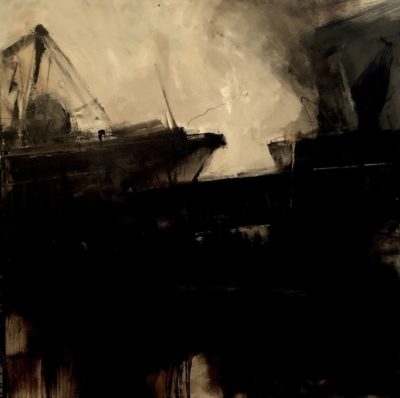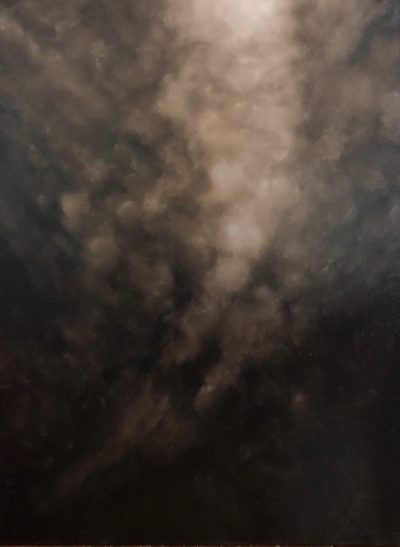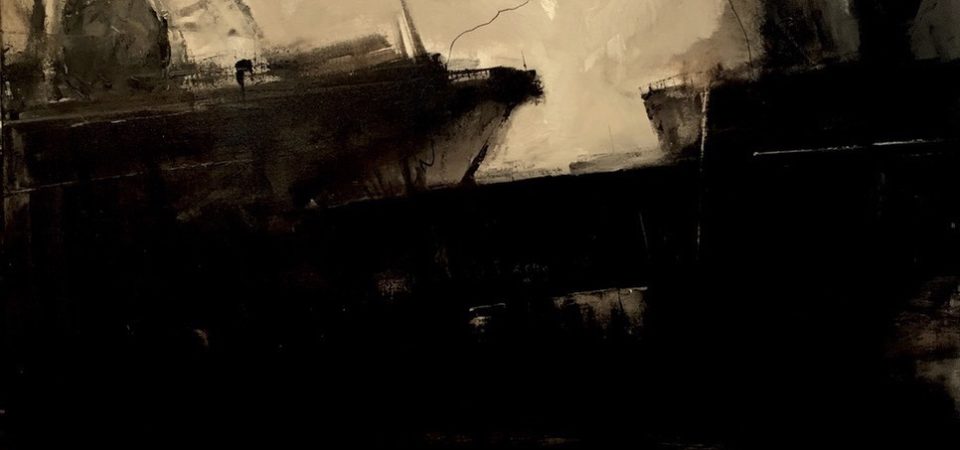Why make art if there isn’t going to be a civilization to receive it? One has to ask because the evidence is clear: the Anthropocene (our current geological epoch, brought on by humans tampering with the planet’s chemistry) has initiated a sixth great extinction. Humans are steadily generating the conditions that have already eliminated 50 – 90% or more of all life on earth five times in the planet’s history. As a result, Homo sapiens faces an unraveling biosphere and widespread societal disruption. It is the most serious problem in human history.
I paint with tar because I picked the worst possible time to become a landscape painter, when the horrible things humanity is doing to nature have become impossible to ignore. My entry into visual art was inspired by the aesthetics of 19th century American Romantic landscape artists like Tomas Cole and George Inness, an aesthetic shared with the classic period of American literature, that of Whitman, Thoreau, Emerson, and Dickinson. But those painters and writers knew a different America, a different world and time.
As I learned more and more about what we’re doing to the planet, it no longer felt authentic or honest to go on making celebratory or formally interesting visions of nature, given how sick and damaged humanity has rendered it. My own long-held and deeply rooted suspicions about the failings of human nature and consumer culture, in particular, have blossomed darkly in my work.
I painted “Event Horizon” I and II primarily with hardware-store roofing tar, a noxious by-product of fossil fuel production. The paintings were inspired by media photographs of the Deepwater Horizon disaster, also called the BP oil spill, in the Gulf of Mexico. In 2010, an explosion on the BP rig led to the largest marine oil spill in history, with an estimated 4.9 million barrels of oil killing wildlife and destroying marine habitats on Louisiana’s coast alone. I also painted the companion piece “Plume” primarily in tar. Intended to evoke air, water, and light in tar, “Plume” is informed by scientific documentation of increasing amounts of Arctic methane, a deadlier greenhouse gas than CO2, escaping from undersea permafrost as the northern oceans warm.
I work with tar because it is primal, chthonic, and miasmatic as well as a toxic signifier of industrialism. On the canvas, it pools, gushes, splatters, and drips like black blood, polluted water, or the crude oil from which it’s derived. Joined with white paint, it puts me in mind of what Clement Greenberg (writing of Jackson Pollock’s monochromatic palette in 1943) called “that American chiaroscuro which dominated Melville, Hawthorne, Poe.”
My paintings in “Environmental Impact II” grew out of “Loomings” (http://www.christophervolpe.com/loomings), a preceding series titled after the first chapter of Melville’s Moby-Dick. Much like “Event Horizon” and “Plume,” the Loomings paintings invite an apocalyptic reading of the American quest, one in which, as Chris Hedges has written of the parallels with Melville’s novel, “a consumer culture based on corporate profit, limitless exploitation and the continued extraction of fossil fuels is doomed” (We Are All Aboard the Pequod https://www.truthdig.com/articles/we-are-all-aboard-the-pequod/).
“The all-grasping Western world,” as Melville called it, was and is apparently hellbent on hunting down everything in nature that can be commoditized. For us, it’s oil from the earth instead of the sea, but Melville’s time and ours are the same. We have always needed dark art and literature to show us the more difficult truths. We need them more than ever now.
In “Deep Adaptation: A Map for Navigating Climate Tragedy (https://mahb.stanford.edu/wp-content/uploads/2018/08/deepadaptation.pdf),” professor Jem Bendell likens trying to stop the climate crisis to attempting to climb a landslide. He questions why he’s even bothering to write when there are really only two outcomes: “If all the data and analysis turn out to be misleading, and this society continues nicely for the coming decades, then this article will not have helped my career. If the predicted collapse comes within the next decade, then I won’t have a career,” he reasons. “It is the perfect lose-lose.”
There are, however, additional reasons for taking action in spite of circumstances, however dire. After all, as St. Augustine said, we live in two worlds, a visible and an invisible, and creativity is one of the most vital ways to navigate between them. We treasure, in the strongest art, authentic and profoundly meaningful intuitions of the conditions of being human. What but humanity’s looming demise could make this any clearer or more important?
It’s been proposed that in every generation a number of artists coalesce, knowingly or not, around a single significant issue in humanity’s history (or so it appears in hindsight). If so, then for the current generation surely that central issue is the Anthropocene and the related teetering of the industrial Western empire. Increasingly, contemporary art reflects geopolitical chaos and rising injustice, economic disruption, resource depletion, overpopulation, massive species extinctions, and the general collapse of the environment we evolved over millions of years to inhabit. With any one of these things threatening to do us in, a preoccupation with aesthetic theory or technique or with producing art with a “pleasing” result will soon seem pointless for many. Only, the will to share the journey in darkness will still be possible, and to stubbornly refute the evident worthlessness of humanity by creating from the best of what we’re made of.
Despite what science has known for decades, all-powerful fossil fuel conglomerates are unapologetically squeezing the last drops of profit from their industry. As always, they’re doing so for immediate gain, despite the waking Leviathan that threatens to end multinational consumer capitalism, if not civilization itself, for good and for all. Artists have a responsibility to respond.
 Christopher Volpe is an artist, writer, and teacher whose landscapes and paintings in tar and oil aim to reflect our culture’s complex and haunted relationships with nature, history, and ourselves. Volpe’s work has received the Saint Botolph Club Foundation Emerging Artist and Nellie Taft awards as well as fellowships and grants from MassMoCA/Assets for Artists, the NH State Council on the Arts and the NH Humanities Council. He was raised in Oyster Bay, NY and currently lives and works in Hollis, NH, and Lowell, MA, respectively. View more of his work at www.christophervolpe.com
Christopher Volpe is an artist, writer, and teacher whose landscapes and paintings in tar and oil aim to reflect our culture’s complex and haunted relationships with nature, history, and ourselves. Volpe’s work has received the Saint Botolph Club Foundation Emerging Artist and Nellie Taft awards as well as fellowships and grants from MassMoCA/Assets for Artists, the NH State Council on the Arts and the NH Humanities Council. He was raised in Oyster Bay, NY and currently lives and works in Hollis, NH, and Lowell, MA, respectively. View more of his work at www.christophervolpe.com

Christopher Volpe
Event Horizon II
2016, Oil and Tar on Canvas, 23 x 32

Christopher Volpe
Event Horizon
2016, Oil and Tar on Canvas, 48 x 48

Christopher Volpe
Plume
2018, Oil and Tar on Canvas, 23 x 32
This blog is part of MAHB’s ENVIRONMENTAL IMPACT II series, a travelling museum’s exhibition.
The MAHB Blog is a venture of the Millennium Alliance for Humanity and the Biosphere. Questions should be directed to joan@mahbonline.org.
The views and opinions expressed through the MAHB Website are those of the contributing authors and do not necessarily reflect an official position of the MAHB. The MAHB aims to share a range of perspectives and welcomes the discussions that they prompt.
